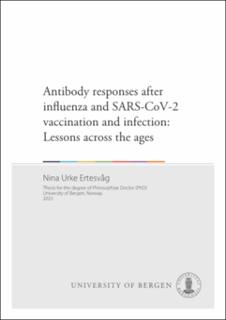| dc.contributor.author | Ertesvåg, Nina Urke | |
| dc.date.accessioned | 2023-10-10T06:39:10Z | |
| dc.date.available | 2023-10-10T06:39:10Z | |
| dc.date.issued | 2023-10-23 | |
| dc.date.submitted | 2023-09-29T13:49:09.125Z | |
| dc.identifier | container/a6/e4/43/78/a6e44378-fdbc-4a5b-ba3b-5b4ee1c8a9a8 | |
| dc.identifier.isbn | 9788230851166 | |
| dc.identifier.isbn | 9788230855652 | |
| dc.identifier.uri | https://hdl.handle.net/11250/3095350 | |
| dc.description.abstract | Influensa A og SARS-CoV-2 er RNA-baserte luftvegsvirus som forårsakar pandemiar og muterer raskt for å oppretthalde ein kontinuerleg sirkulasjon. Eit komplekst samspel mellom immunresponsar hjå verten og viruset er forma gjennom etablerte minne frå den første infeksjonen, tidlegare vaksinasjonar og alder. Dette doktorgradsarbeidet karakteriserer antistoff-responsar mot influensa A/H3N2 og SARS-CoV-2 i ulike aldersgrupper etter infeksjon og vaksinasjon.
Den første influensainfeksjonen, i tillegg til summen av eksponeringar gjennom livet, påverkar framtidige immunresponsar. Vi fann kryssreaktive antistoff-responsar hjå vaksne og barn mot A/H3N2-virus tilbake til fødselsåret deira. Sjølv om antistoff mot dei nyaste virusa dominerte landskapet, kunne antistoff også kryssreagere mot framtidige, epidemiske virus.
Ein laboratoriebasert og hurtig hemagglutinasjonstest (HAT) kan forenkle studiar om immunitet mot SARS-CoV-2 og brukast til å måle surrogat-nøytraliserande antistoff. mRNA-vaksiner var mindre immunogene hjå eldre, basert på lågare kryss-reaktivitet mot nye virusvariantar, med mindre dei hadde vore infiserte tidlegare. Vi fann at eldre trengte to vaksinedosar for å produsere tilsvarande HAT-antistoff mengder samanlikna med yngre vaksne med éin vaksinasjon eller tidlegare infiserte personar.
Det er få studiar på vedvarande SARS-CoV-2-symptom, også kjent som post COVID-19-tilstand, blant barn og ungdom, spesielt etter delta- og omikron-infeksjon. Faktorar assosiert med vedvarande symptom i aldersgruppa 10-20 åringar var akutte symptom, høgare alder, høgare antistoff-titer mot piggeproteinet og kvinneleg kjønn. I same kohort fann vi høgare antistoff og færre omikron BA.1/2-reinfeksjonar hjå COVID-19-vaksinerte samanlikna med uvaksinerte. Vaksineeffekten var derimot kortvarig, 22 dagar, trass i hybridimmunitet.
Desse funna understrekar nytten av raske og enkle analysar for å evaluere infeksjon- og vaksinasjonsresponsar. Det er behov for forbetra vaksineeffekt for å redusere byrden av COVID-19 og vedvarande symptom hjå unge menneske. Samla sett kan kryssreaktive antistoff vere gunstige i møte med nye luftvegsvirus. | en_US |
| dc.description.abstract | Influenza A and SARS-CoV-2 are respiratory RNA viruses which cause pandemics, and rapidly mutate ensuring their continuous circulation. There is a complex interplay between the host immune responses and the virus, influenced by prior memory from the initial infection, vaccination, and age. This thesis characterises antibody responses to influenza A/H3N2 and SARS-CoV-2 in different age groups after infection and vaccination.
The priming influenza infection, as well as the summary of life-time exposures, is known to affect subsequent immune responses. We found cross-reactive antibody responses in adults and children against A/H3N2 viruses back to their year of birth. Although antibodies to the most recent viruses dominated the antibody landscapes, antibodies also cross-reacted against future epidemic viruses.
Studies of SARS-CoV-2 immunity can be simplified by the use of a rapid, laboratory-based hemagglutination test (HAT) to measure surrogate neutralising antibodies. mRNA vaccines were less immunogenic in the elderly with lower cross-reactivity to new variants, unless they had been previously infected. We found that the elderly required two vaccine doses, to produce HAT antibodies comparable to after one vaccination in younger adults or previously infected subjects.
Long-term SARS-CoV-2 symptoms, known as post COVID-19 condition, are understudied in children and adolescents, especially after infection with the delta and omicron variants. In 10-20 year olds, we identified acute symptoms, older age, higher spike-specific antibody titres and female sex as factors associated with persisting symptoms. In the same cohort, we found higher antibodies and fewer omicron BA.1/2 reinfections in COVID-19 vaccinees than unvaccinated. However, vaccine effectiveness had a short duration of 22 days, despite hybrid immunity.
Our findings highlight the utility of rapid and simple assays for evaluation of infection and vaccination responses. There is a need for improved vaccine effectiveness to reduce the burden of COVID-19 and long-term symptoms in young people. Overall, cross-reactive antibodies can be favourable in the face of emerging respiratory viruses. | en_US |
| dc.language.iso | eng | en_US |
| dc.publisher | The University of Bergen | en_US |
| dc.relation.haspart | Paper I: Ertesvåg NU, Cox RJ, Lartey SL, Mohn KG, Brokstad KA, Trieu MC. Seasonal influenza vaccination expands hemagglutinin-specific antibody breadth to older and future A/H3N2 viruses. npj Vaccines. 2022;7(1):67. The article is available at: <a href="https://hdl.handle.net/11250/3040244" target="blank">https://hdl.handle.net/11250/3040244</a> | en_US |
| dc.relation.haspart | Paper II: Ertesvåg NU, Xiao J, Zhou F, Ljostveit S, Sandnes H, Lartey S, Sævik M, Hansen L, Madsen A, Mohn KG, Fjelltveit E. A rapid antibody screening haemagglutination test for predicting immunity to SARS-CoV-2 variants of concern. Communications Medicine. 2022;2:36. The article is available at: <a href="https://hdl.handle.net/11250/3054531" target="blank">https://hdl.handle.net/11250/3054531</a> | en_US |
| dc.relation.haspart | Paper III: Ertesvåg NU, Iversen A, Blomberg B, Özgümüş T, Rijal P, Fjelltveit EB, Cox RJ, Langeland N, Haug K, Sandnes H, Mohn KG. Post COVID-19 condition after delta infection and omicron reinfection in children and adolescents. EBioMedicine. 2023;92:104599. The article is available at: <a href=" https://hdl.handle.net/11250/3095348" target="blank">https://hdl.handle.net/11250/3095348</a> | en_US |
| dc.relation.haspart | Paper IV: Ertesvåg NU, Rijal P, Langeland N, Cox RJ, COVID-vaccine protection against Omicron break-through infection in children and adolescents. The article is not available in BORA. | en_US |
| dc.rights | Attribution-NonCommercial-NoDerivs (CC BY-NC-ND). This item's rights statement or license does not apply to the included articles in the thesis. | |
| dc.rights.uri | https://creativecommons.org/licenses/by-nc-nd/4.0/ | |
| dc.title | Antibody responses after influenza and SARS-CoV-2 vaccination and infection: Lessons across the ages | en_US |
| dc.type | Doctoral thesis | en_US |
| dc.date.updated | 2023-09-29T13:49:09.125Z | |
| dc.rights.holder | Copyright the Author. | en_US |
| dc.contributor.orcid | 0000-0001-5243-9101 | |
| dc.description.degree | Doktorgradsavhandling | |
| fs.unitcode | 13-25-0 | |

